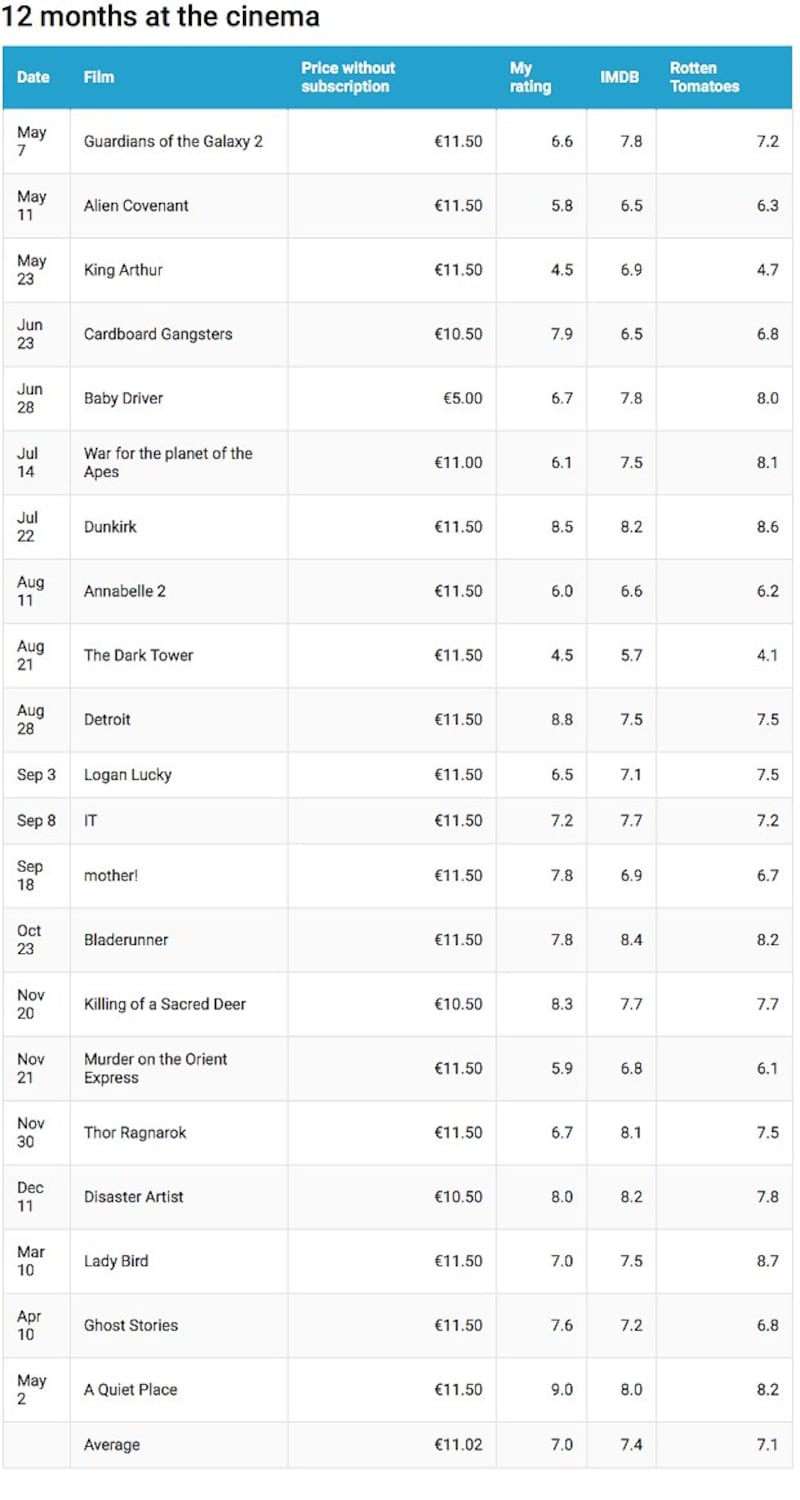“One to King Arthur please,” I say to the guy behind the till at the Odeon. It’s difficult to articulate the smug thrill of handing over a Limitless card instead of cash at the cinema. For one heady moment, I amn’t a 27-year-old man going to see a ropey epic on his own, midweek. I’m, instead, an 18-year-old lad, brandishing his passport at the off-licence on his birthday. Magic.
“It’s as well you’re on Limitless,” he says, folding my ticket and handing it over with the receipt, “because the film is complete shite.”
And he wasn’t wrong.
It was during this, my third trip to the cinema using the Odeon’s monthly subscription bundle, that I was introduced, brutally, to the first con of the game. You will, without a doubt, see many terrible films.
Cinemagoers will be familiar with ads about “the exclusive club everyone’s joining”. At the Odeon, it’s the Limitless promotion, whereby you pay a monthly subscription of €21.99 (€19.99 without Dublin cinemas). For your loyalty, you can see as many standard 2D films, as many times as you want, as often as you want. There’s a minimum subscription period of 12 months and it’s a little cheaper if you pay up front; €250 versus €263.88 annually.
The offer always tempted me, and I routinely bottled it. One year ago, driven mad with curiosity and healthy amounts of free time after work, I signed up to the monthly Dublin-inclusive option, armed with a cunning plan. I was going to decipher, mathematically, if this deal was really worth it.
For one year, I went to the cinema as often as I could, taking with me a notebook which eventually became a robust spreadsheet that I’m unreasonably proud of.
I recorded details: the date, the real price of the movie (what I would have spent), my rating (on a ten-point scale, to one decimal place), the average IMDb and Rotten Tomatoes score (because unless you’re literally me, you won’t care what I think about films), and any pros and cons I encountered (see above, re: King Arthur)
Minimum requirement
I set a minimum requirement for renewal. If the average movie I saw was at least a 6.5 on my own scale, and the average real price of the film was greater than what I spent via the monthly charge, it made sense to stick with it.
Before looking at the numbers, I want to address the salty elephant in the foyer. The food. For this experiment, I left it out of the equation entirely.
Increasing your cinema trips presents more opportunities to overpay for popcorn. But the act of going more also alters your eating habits. If you normally go twice a year, you probably won’t think much of spending 9.50 on a large popcorn combo. Push those numbers to three times a month and you become a deft smuggler of contraband M&Ms.

Odeon and Cineworld offer similar deals, with concessions on selected food and drinks. That’s a false economy. Ten per cent discount or not, you’re still paying too much for snacks. Anything that increases that behaviour should be avoided.
The beginning of the year is a blur of showing times and sheepish peeks at the hilarious photo on my Limitless ID. High on power, I blasted through three movies in the first month, May 2017. The quality of those films slipped dramatically - Guardians of the Galaxy 2 (6.6), Alien Covenant (5.8) and the insufferable King Arthur (4.5, tied lowest of the bunch with The Dark Tower).
I didn’t care. I was blinded by greed; the quality of experience mattered little. My numbers were incredible.
Each of May’s movies would have cost 11.50. By the end of the month, I’d already seen one “free” film. The house always wins? Not this time, mate. They probably had my silly photo pinned up in head office.
June was a disaster. It wasn’t the films: Cardboard Gangsters (a generous 7.9) followed by Baby Driver (a thrifty 6.7). No; my giddy eagerness meant I accidentally went to see the latter on a Wednesday, when the real price of the film would have been €5, due to an ongoing promotion.
Hidden restrictions
Here we find pitfall number 2: the hidden restrictions. To make this escapade work financially at the Odeon, you simply cannot go on a Wednesday. Right from the start, you’re working to a six-day week.
Perhaps, too, you have friends signed up to an offer at a different cinema. Say goodbye to them. There is no peace agreement conceivable that could persuade a subscriber of one chain to attend another. Prepare to go on your own. Very often.
Deflated in July, I resolved not to dwell on monthly targets, and just go as often as I could. Things trundled along reasonably well until the new year.
Around then, I took on a big project. Slowly, the overflowing bounty of buttery free time I’d idly gnawed by the fistful became a smattering of salty kernels, beat into the corner of the bag.
Days turned to weeks and months. A spreadsheet I used to open with unbridled glee became a source of disappointment. Nothing in January, or February. One in March? Pathetic. Meanwhile, Mr Odeon cackled in his golden bath of direct debits.
Things were looking poorly coming into spring. I’d seen plenty of films, but very few during Oscar season. I missed The Shape of Water, The Post and Churchill. I also left that new Star Wars hackjob on the table, but that’s a different story.
In May, I saw my last film of the year. A Quiet Place, John Krasinski’s exquisitely tense horror debut, was incredible. At 9.0, it earned the highest rating of the year, followed by Detroit (8.8) and Dunkirk (8.5). It ended the experiment on a high. It also massaged the stats late in the game.
The final tally: In a year, I saw 21 films. Happily, the average quality rating was better than I expected at 7.0, with IMDb at 7.4 and Rotten Tomatoes at 7.1.
The ticket prices told a different story. I paid, on average, €12.57 per film and €263.88 total for the year. Had I simply paid “full price”, the annual cost would have been €231.50, or an average of €11.02 per film.
Even without the Dublin cinemas, I’d have made a loss, at €239.88 total.
There you have it. A mathematical failure, albeit a close one; three more films would have made it profitable, but only by a few cent per film.
Yet, I enjoyed it. The inclination to go to the cinema in your free time carves out two hours when turning off your phone, or at least putting it on silent, is a requirement for anybody carrying a shred of soundness in their heart. What’s rare is wonderful.
If you can reserve the hours and reasonably predict your free time for a year, then you may do better than I did. Be prepared to see some truly awful films alongside the brilliant ones; it evens out in the end.
By now, I’ve rumbled my own M&M smuggling racket and am probably barred, but I may decide to keep the subscription for another month or two. If Mr Odeon thinks he’s having the last laugh, he’s having a laugh.



















